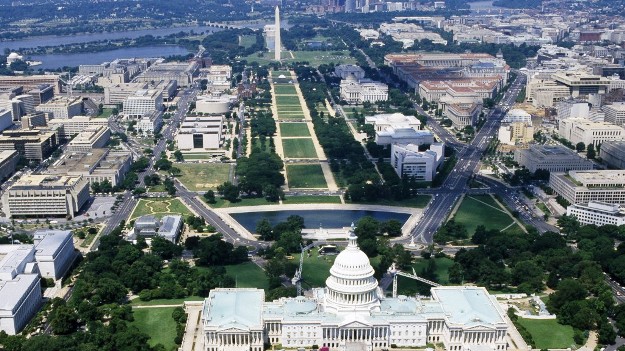The seat of American government is also a beautiful city, a celebration in marble and stone of the ideals on which democracy was founded. Though laid out roughly according to the original 1791 plan by French military engineer Pierre-Charles L’Enfant, the city has changed considerably over the years. Even its centrepiece National Mall—a majestic two-mile greensward running west from the Capitol Building, lined with some of the nation’s most important monuments and civic and cultural institutions—didn’t assume its current form until the early 20th century.

At its centre, the Washington Monument was the Mall’s first presidential memorial, completed in 1884. Thrusting skyward 555 feet, it offers visitors a spectacular 360-degree view from its peak. To the west, the neoclassical Lincoln Memorial is probably the most emotional of the Mall’s presidential memorials. Built to resemble a Greek temple, it has 36 Doric columns representing the 36 states in the union at the time of Lincoln’s death. Inside, Daniel Chester French’s massive sculpture of the seated president gazes out, the powerful words of his Gettysburg Address etched behind him, below a mural depicting the unity of North and South. For the most profound experience, visit at night, after the crowds have thinned out.
South of the Washington Monument on the banks of the Tidal Basin, the Thomas Jefferson Memorial was designed in 1936 by John Russell Pope and modelled on the Pantheon in Rome. Inside, a 19-foot bronze statue of the third president stands surrounded by passages from the Declaration of Independence. The Jefferson Memorial was planned and constructed during the presidency of Franklin Roosevelt, so it’s apt that the next presidential memorial built on the Mall was to that great man himself.
Dedicated in 1997, the Franklin Roosevelt Memorial is composed of four outdoor galleries, one for each of his terms in office, with waterfalls, shade trees, statuary and the president’s words carved into walls of red South Dakota granite. Near the entrance, visitors are greeted by a statue of Roosevelt seated in his wheelchair, his beloved Scottish terrier, Fala, and First Lady Eleanor nearby.
The Mall’s most moving memorial is to the men and women who fought and died in America’s longest war. The Vietnam Veterans Memorial is a simple V-shaped wall of polished black granite set into the earth, inscribed with the names of the 58,245 soldiers killed or MIA (Missing In Action) as a result of the war. Dedicated in 1982, the wall’s unconventional design, by Maya Lin, was initially controversial but has since been recognised for its powerful evocation of the personal cost of war. Nearby, the Korean War Veterans Memorial consists of a circular Pool of Remembrance and sculptures of 19 infantrymen crossing a field.
Located at the other end of the slender reflecting pool that stretches between the Lincoln and Washington memorials, the National World War II Memorial has a more traditional design. Its central plaza and fountain are surrounded by 56 granite pillars and a ‘Freedom Wall’ with 4,000 sculpted gold stars commemorating the 400,000-plus Americans who died in the war.
The Mall is particularly beautiful when illuminated at night, and in early spring when thousands of Japanese cherry trees burst into bloom around the Tidal Basin.

